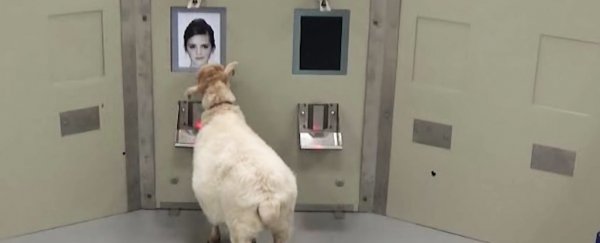We've known for a while that sheep, with their social nature and big brains, can recognise faces of other sheep and human handlers. Now a study has shown they can also learn to identify unfamiliar humans they've never met - after only seeing their photos.
This wasn't just done so scientists could hang out with cute sheep - the results of this study are part of a larger body of work aimed at understanding how sheep learn, to give researchers clues on what goes wrong in the brain when diseases such as Huntington's disrupt normal processing.
Using photos of well-known figures like Barack Obama and Emma Watson, sheep were trained to recognise people from images, even when they were shown from different angles. The sheep could essentially match a 2D image to a 3D person and spot changes in perspective.
"Anyone who has spent time working with sheep will know that they are intelligent, individual animals who are able to recognise their handlers," says senior researcher Jenny Morton from the University of Cambridge.
"We've shown with our study that sheep have advanced face-recognition abilities, comparable with those of humans and monkeys."
For the study, eight Welsh Mountain sheep were trained to recognise the faces of Barack Obama, Emma Watson, Jake Gyllenhaal, and Fiona Bruce, with food used to reward the animals for picking the photo each time, rather than a blank space or inanimate object.
In the next stage, the same celebrity photos were put up against photos of other faces, and the sheep chose the pre-learned face 8 times out of 10.
When the same celebrity photos were shown at an angle, the sheep still did well, with performance only dropping about 15 percent – that's about the same drop that would be expected in humans too. (You can see the training process in the video below.)
In some test runs, one of the photos shown was of one of the sheep handlers, and here the animals went to the familiar face 7 times out of 10, without any prior training, though they often did a double-take first.
"We know that sheep can recognise their handlers, but I was still impressed they could do this," Morton told Ian Sample at The Guardian. "Face recognition is a sophisticated process, but they've got big brains, they see other sheep, and they use this processing to recognise one another."
As face recognition involves several different parts of the brain, monitoring how this face-spotting talent weakens or stays the same could give us new ways of spotting the earliest signs of brain disease.
The research team has actually been studying sheep as an animal model for the neurodegenerative Huntington's disease - the scientists have a group of sheep genetically modified to have the mutation that causes it.
According to the team, with their large brains and long lives, sheep are a good model for studying some human brain problems - and part of the research process is to understand the cognitive abilities of sheep in general.
"Our study gives us another way to monitor how these abilities change, particularly in sheep who carry the gene mutation that causes Huntington's disease," says Morton.
In the case of Huntington's, for which there's no known cure, those with the disease have trouble recognising facial emotion and also experience problems with motor coordination, managing moods, and recalling memories.
"We're hoping that with treatments that improve Huntington's pathology we'll see the reversal of some of the cognitive changes," Morton told The Guardian. "We want to understand how the disease starts so we can start thinking about preventing it."
The research has been published in Royal Society Open Science.
